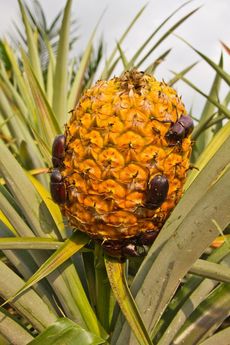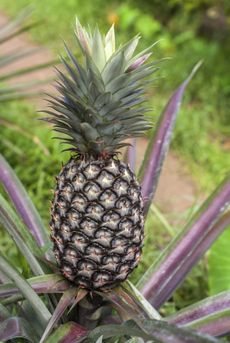Growing Pineapples: Learn About The Care Of Pineapple Plants


When to plant: springI would venture to say that most of us consider pineapples to be a rather exotic, tropical fruit, right? Because of this, many people think they can’t grow them, but amazingly you can, simply by planting the pineapple top you just purchased from the supermarket. If you're interested in growing a pineapple tree, read on to learn how to plant a pineapple and about pineapple plant care.
Pineapple Information
Pineapple has been cultivated for thousands of years. Likely native to Brazil and the American tropics, pineapple was introduced to areas of exploration by New World explorers from the 1500’s to 1700’s.
Commercial trade was established during the early 19th century from the West Indies and the Caribbean, but when refrigeration became the norm on sea ships, production ramped up in Hawaii, Asia, and Africa.
Today, pineapple is one of the most important cultivated tropical fruits, after mango, banana, and citrus.
A member of the family of bromeliads, pineapple is an herbaceous perennial. Unlike most bromeliads such as tillandsia and Spanish moss, pineapple grows in soil on ground level rather than in trees.
Pineapple Plant Description
Pineapple plants have long, sword-like leaves that run in a spiral around a central stem and a terminal inflorescence. These leaves may range in size from 2-8 inches (5-20 cm) long in young plants up to 5 feet (1.5 m) long on mature plants. Some varieties have spines along the leaves while others are spineless. Mature plants may grow to 3-6 feet (0.9-1.8 m) both tall and wide.
When the plant has produced 70-80 leaves it is ready to flower. The emergence of the inflorescence (flower) is called the red heart stage due to the reddish bracts at the base of the bloom. The inflorescence is made up of 50-100 individual flowers along with up to 150 short leaves.
Gardening tips, videos, info and more delivered right to your inbox!
Sign up for the Gardening Know How newsletter today and receive a free download of our most popular eBook "How to Grow Delicious Tomatoes."
Over the course of 20-40 days, one to ten flowers open daily at midnight, closing the following evening. The resulting fruit is called a syncarp, a single fruit made from many individual blooms.
Growing Pineapples
Growing pineapples really is very simple. Due to their tough leaves, they lose little water through evaporation. They have small root systems like other bromeliads, and are not fussy about the quality or quantity of their soil. Because of this, they make excellent container grown plants, especially nice for those of us whose climate is less than tropical. If you do live in a warmer region, growing pineapple plants in the garden is a match made in heaven.
How to Plant a Pineapple Top
Pineapples can be propagated in four ways: from ratoon suckers, slips, the stalk below the fruit, or the crown of the fruit. Commercial growers usually start plants from slips and suckers, but the easiest way for most of us is to start a plant from the crown of the pineapple, or leafy top of the fruit.
To use your store bought crown for propagation, make sure to start with a pineapple that has a healthy-looking top. Use a sharp knife to slice off the top of the pineapple. Remove any excess fruit, as well as a few of the lower leaves. You can just pull them off.
Make a two inch (5 cm) hole in a container of potting soil, and put your pineapple top in it. Make sure not to cover up any of the leaves.
Plant crowns in full sun, allowing 1-3 feet (30-90 cm) between plants. Plant in nutrient rich, sandy loam with good drainage. If you live in a frost-free zone, you can plant directly into your garden.
Planting Pineapple Pups
Growing pineapples from pups is very similar to growing them from crowns. If you are starting a plant from pups, remove the pup from the parent plant and allow it to air dry in the shade a couple of days prior to planting. After that, follow all the same instructions as for crown planting.
Care of Pineapple Plants
Pineapple care is relatively straightforward as long as you follow a few guidelines.
Watering
Pineapples are fairly drought tolerant and can thrive with very little water. If you are in a low water area, or if you never remember to water your plants, a thick layer of mulch should be incorporated to reduce evaporation. You might also want to consider growing your pineapples in a slightly shaded area, especially if you live in a tropical or sub-tropical area.
If, however, you live in a region with plentiful rain, that’s okay too. If you have the pineapple in a pot, be sure it has well-draining soil and drainage holes. Don’t drown the pineapple by overwatering though! Allow the soil to dry out completely before watering again.
Fertilizing
Additional pineapple plant care is minimal. Pineapple leaves uptake most of their nutrition. For the first few months after planting, just leave the plant alone– no fertilizer, that is. After that, you can use liquid fertilizer such as fish emulsion or seaweed extract. Make a diluted solution and use a watering can to apply to the soil and the leaves.
The new plant will take several months to develop a root system, so allow some of the fertilizer to collect in the leaf axils. After six months, the plant will have developed sufficient root structure. At this point, fertilize at the root zone, not the leaf axils.
Stay away from artificial or concentrated fertilizers, which can burn the plant.
If you use chicken manure, sprinkle it on the soil at the base of the plant and into the bottom leaves. The color of the leaves will be a telltale sign of whether or not to feed the plant. If they get a reddish/purple tinge, it’s time to fertilize.
The ideal way to feed your pineapple is to incorporate compost into the soil prior to planting and mulch heavily around the plant. Some of the mulch/compost will end up in the lower leaves as well as around the shallow root system, and as it breaks down, it will nourish the plant.
Cold tolerance
The only other thing to pay attention to is if you live in a cooler climate. If so, then you probably have the pineapple outdoors in a pot. Be sure to move the plant inside in an area with lots of sun as the weather begins to cool.
Pineapples are no match for frost, so move it inside well before temperatures dip below freezing. Temps below 60 F (16 C) or above 90F (32 C) will slow the growth of the plant but are not damaging.
Problems
There are a few common pineapple problems. Vulnerable to root rot, pineapples should never be allowed to sit in standing water. Other diseases that might affect pineapple include bacterial heart rot, butt rot, black rot, white leaf spot. Marbling, mealybug wilt and Phytophthora heart and root rot.
Pineapple pests include nematodes, scales, and mealy bugs.
Harvesting Pineapple
Only a single pineapple fruit is produced per plant, which will take 18-32 months to mature. When it smells ripe and the peel has become a golden brown, your pineapple is ready to harvest.
A pineapple plant can be forced to flower out of season once it is at least 16 months old. While the fruit will be about the same size as unforced fruit, it won't taste as good.
Want to learn more about re-growing food scraps? Head over to the GKH Learning Channel and sign up for our course How to Grow A No-Waste Kitchen Garden.

Amy Grant has been gardening for 30 years and writing for 15. A professional chef and caterer, Amy's area of expertise is culinary gardening.
-
 How To Grow Garden To Table: A Guide For Home Cooks
How To Grow Garden To Table: A Guide For Home CooksWhat could be better than a meal that comes directly from garden to table? Show off your gardening and culinary skills with the very freshest food.
By Bonnie L. Grant
-
 Want a Backyard Mini Orchard? Create Your Own Container Orchard
Want a Backyard Mini Orchard? Create Your Own Container OrchardEasier to care for in small spaces, a backyard mini-orchard makes sense for busy gardeners and juicy fruit is the reward.
By Teo Spengler
-
 Pink Pineapples: Learn About Super Sweet Pinkglow Pineapples
Pink Pineapples: Learn About Super Sweet Pinkglow PineapplesWhat is a pink pineapple? If you've never seen a Del Monte Pinkglow® pineapple, you're in for a special treat.
By Laura Miller
-
 Dealing With Pineapple Problems: Managing Pineapple Pests And Diseases
Dealing With Pineapple Problems: Managing Pineapple Pests And DiseasesGrowing pineapples isn?t always all fun and games, but you can produce a perfect pineapple with more information about pests and diseases that affect this plant. Click this article to learn about common pineapple problems.
By Kristi Waterworth
-
 Pineapple Plant Fruiting: Do Pineapple Plants Fruit More Than Once
Pineapple Plant Fruiting: Do Pineapple Plants Fruit More Than OnceHave you ever wondered about pineapple plant fruiting? For instance, how often does pineapple bear fruit? Do pineapples fruit more than once? If so, does the pineapple die after fruiting? Find the answers to these questions in this article.
By Amy Grant
-
 Pineapple Harvesting: Tips For Picking Pineapple Fruits
Pineapple Harvesting: Tips For Picking Pineapple FruitsI have a devil of a time picking the ripest fruit when I'm at the grocer's. How about picking pineapple fruits from homegrown plants? How do you know when to pick a pineapple and how to harvest a pineapple plant? Click here for more info.
By Amy Grant